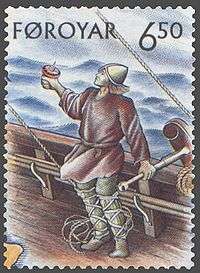Wadmal

Wadmal (Old Norse: vaðmál; Norwegian: vadmål, "cloth measure") is a coarse, dense, usually undyed wool fabric woven in Iceland, Norway, Sweden, Greenland, and the Orkney, Faroe and Shetland Islands from the Middle Ages into the 18th century. Wadmal was woven on the warp-weighted loom used throughout these areas of Norwegian influence, and was usually a 2/2 twill weave, although some medieval sources outside Iceland describe wadmal as tabby or plain-woven. In remote regions, wadmal remained the primary fabric for working people's clothing into the 18th century[1][2]
Wadmal was a medium of exchange throughout Scandinavia. Wadmal was accepted as currency in Sweden, Iceland, Shetland, and Ireland, and exchange rates defined the equivalent of various grades of wadmal (measured in ells) in silver and in cows.[1][2][3] Wadmal was the main export of Iceland, where length, width, thread count, and weight for different grades were fixed by law.[4]
See also
References
| Look up wadmal in Wiktionary, the free dictionary. |
- 1 2 Crawford, Barbara E., Beverley Ballin Smith, Norske videnskaps-akademi, and Society of Antiquaries (1999). The Biggings, Papa Stour, Shetland: the history and excavation of a royal Norwegian farm. Society of Antiquaries of Scotland. pp. 201, 265. ISBN 0-903903-15-6. Retrieved 19 April 2010.
- 1 2 Østergård, Else (2004). Woven into the Earth: Textiles from Norse Greenland. Aarhus University Press. pp. 62–64. ISBN 87-7288-935-7.
- ↑ Allen, Larry (2009). The Encyclopedia of Money (2 ed.). ABC-CLIO. p. 73. ISBN 1-59884-251-X. Retrieved 22 April 2010.
- ↑ Pulsiano, Phillip; et al., eds. (1993). Medieval Scandinavia: An Encyclopedia. Garland Press. p. 99. Retrieved 22 April 2010.


.svg.png)